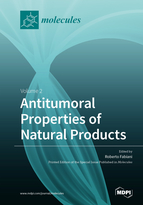Antitumoral Properties of Natural Products
A special issue of Molecules (ISSN 1420-3049). This special issue belongs to the section "Natural Products Chemistry".
Deadline for manuscript submissions: closed (31 October 2019) | Viewed by 203267
Special Issue Editor
Interests: cancer chemoprevention; nutrition; olive oil; polyphenols; natural bioactive compounds; antioxidants; oxidative stress; genotoxicity; mutagenicity; apoptosis; cell cycle regulation
Special Issues, Collections and Topics in MDPI journals
Special Issue Information
Cancer is a major public health concern, being one of the main causes of morbidity and mortality worldwide. Carcinogenesis is a complex multistage process in which normal cells trough an alteration of DNA structure/function are transformed into malignant cells acquiring several properties, such as abnormal proliferation and reduced apoptosis. Studies have demonstrated both in vitro and in vivo that many bioactive compounds, from different natural sources, are able to influence a number of pathways related to tumor development. Many different cancer-specific molecular mechanisms and targets have been identified making it possible to use such compounds as alternative therapeutic or adjuvant treatments, or as chemopreventive agents. This Special Issue aims to identify the most recently-discovered new natural bioactive products with anticancer properties and will review their molecular mechanisms of action.
Prof. Dr. Roberto Fabiani
Guest Editor
Manuscript Submission Information
Manuscripts should be submitted online at www.mdpi.com by registering and logging in to this website. Once you are registered, click here to go to the submission form. Manuscripts can be submitted until the deadline. All submissions that pass pre-check are peer-reviewed. Accepted papers will be published continuously in the journal (as soon as accepted) and will be listed together on the special issue website. Research articles, review articles as well as short communications are invited. For planned papers, a title and short abstract (about 100 words) can be sent to the Editorial Office for announcement on this website.
Submitted manuscripts should not have been published previously, nor be under consideration for publication elsewhere (except conference proceedings papers). All manuscripts are thoroughly refereed through a single-blind peer-review process. A guide for authors and other relevant information for submission of manuscripts is available on the Instructions for Authors page. Molecules is an international peer-reviewed open access semimonthly journal published by MDPI.
Please visit the Instructions for Authors page before submitting a manuscript. The Article Processing Charge (APC) for publication in this open access journal is 2700 CHF (Swiss Francs). Submitted papers should be well formatted and use good English. Authors may use MDPI's English editing service prior to publication or during author revisions.
Keywords
- Cancer
- Chemoprevention
- Bioactive compounds
- Natural products
- DNA damage
- Apoptosis
- Proliferation







